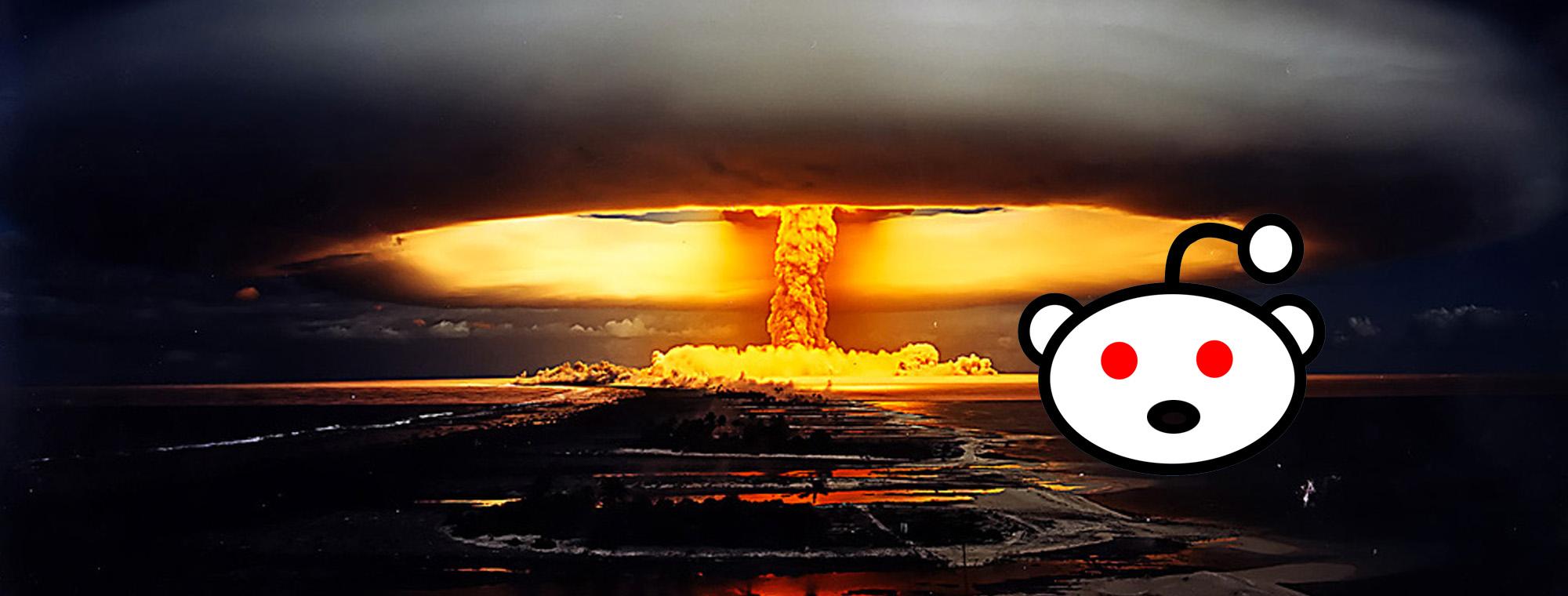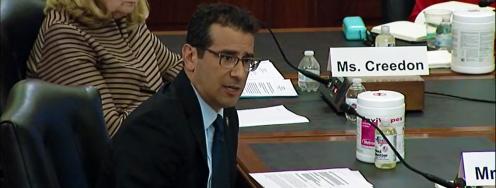Arms Control Association director Daryl G. Kimball hosted an AMA (‘Ask me Anything’) session on Reddit, the 25th most visited web site in the world. Reddit’s AMA regularly features noteworthy individuals with unique expertise to take questions from anybody in the Reddit community – comparable to a massive online press conference with global reach. On September 19, Daryl took questions from the Reddit community on various nuclear weapons issues, including the Comprehensive Nuclear Test Ban Treaty (CTBT), which the US Senate has repeatedly blocked since President Bill Clinton signed it 20 years ago; the growing North Korean nuclear threat; and the burgeoning new nuclear arms race with Russia. Here are some of the questions and answers addressed during the AMA:
Question from EveningAllAfternoon: How much does the US spend on maintaining and modernizing the nuclear stockpile per year compared to how much is spent on non-proliferation activities?
Daryl Kimball: The Departments of Defense and Energy requested approximately $23 billion in Fiscal Year 2015 to maintain and upgrade these systems and their supporting infrastructure, according to the nonpartisan Congressional Budget Office. They estimate that nuclear forces will cost $348 billion between FY 2015 and FY 2024. Three independent estimates put the expected total cost over the next 30 years at as much as $1 trillion. Internal DoD cost estimates suggest the cost will rise even further.
There is more on US nuclear weapons spending here: https://www.armscontrol.org/factsheets/USNuclearModernization
By comparison, the US government spends less than 1-2 billion dollars per year on programs to advance nuclear nonproliferation (with the estimates varying depending on what you count.)
Question from HenrySkrimshander: The CTBT international monitoring system has a lot of value for other areas of science and policy (earthquake and tsunami monitoring, nuclear accident fallout tracking, etc.). Who provides the system with its funding? And what happens to the system if enough countries do not ratify the treaty?
DK: Indeed, in addition to monitoring for nuclear weapon test explosions that are prohibited by the 1996 Comprehensive Test Ban Treaty, the global monitoring system - which involves hydroacoustic, infrasound, seismic and radionuclide stations - provides real time data to help warn about tsunamis for member states and it provides valuable data for earthquake prediction.
So far the CTBT has broad global support – 183 states have signed and only North Korea has conducted nuclear tests in this century – but 8 more states still need to ratify to bring it into force. The system will continue to operate as long as states continue to make their financial contributions to maintain the system; and the monitoring system will help detect and deter clandestine nuclear test even before the treaty enters into force. Individual states make annual contributions on a sliding scale, most states contribute on time and some, like the US have made additional voluntary contributions.
But we cannot afford to take the work of the CTBT Organization and its monitoring system for granted.
Question from azakre: What do you think has been the greatest success/failure in nuclear policy over the past 5 years?
DK: There have been a number of important nuclear weapons risk reduction successes over the past several years. I would say the 2015 Iran nuclear deal, which verifiably rolled back Tehran's capacity to produce bomb material and will block its ability to build a bomb for at least a decade has to be the most significant.
On the other hand, the inability of the international community to halt North Korea's nuclear and missile testing and its renewed production of nuclear bomb material has to be the most serious shortcoming. It is clear that sanctions against the DPRK are warranted and can help, but sanctions alone are not working. They need to be implemented more efffectively - esp by China - and the US and our partners need to explore every possible diplomatic opportunity to engage diplomatically with the regime in Pyongyang. Not assurance of success, but it is essential that we try to neogtiate a freeze of their program.
Question from tonyfleming: Which countries have the most nuclear weapons today, and how many do they have?
DK: There are nine countries that posses nuclear weapons today. The United States and Russia possess more than 90% of them. At any given moment, the US and Russia each have about 1,000 nuclear warheads that are deployed and can be delivered within an hour of a launch order. There are many more in reserve. We have a handy fact sheet on our web site with the key numbers here: https://www.armscontrol.org/factsheets/Nuclearweaponswhohaswhat
Question from Frajer: How worrisome is North Korea with regards to nuclear weapons?
DK: We should be worried. With its five nuclear tests and multiple ballistic missile tests, North Korea has developed a basic capability to strike targets in Northeast Asia with nuclear weapons and may now be preparing to try to operationalize that capability. This has negative implications for South Korea, China, Russia, Japan, and the United States, but there is still a narrow window of opportunity to head-off that threat.
Question from ns_cip: With the 20th anniversary of the UN adoption of the Comprehensive Nuclear Test Ban Treaty early this month, I was wondering if you could speak on the importance of future ratification by the United States. What are the benefits to national and international security and what are the drawbacks? Do you believe the Obama administration's recent push in support of the CTBT will result in progress in ratification efforts or is it a matter of waiting for a different political climate in the Senate down the road?
DK: The last of the United States’ 1,052 nuclear tests was in Sept. 1992. President Bill Clinton was the first to sign the CTBT on Sept. 24, 1996. The United States has no technical or military need to resume nuclear testing and its in Washington's and the world's interest to ensure that other states don't do so – because nuclear tests enable the development of more advanced types of nuclear warheads.
But to finally close the door on nuclear testing and bring the CTBT into force, the United States must provide stronger leadership by reconsidering and ratifying the treaty.
Much has changed since the Senate last examined the CTBT in 1999 and rejected the treaty after a brief and highly partisan debate that centered on questions about the then-unproven stockpile stewardship program and then-unfinished global test ban monitoring system.
Fewer than a quarter of the Senators who were in the Senate in 1999 are still there today.
Today the global monitoring system can detect any mlitarily signficant test explosion and US programs to maintain its nuclear arsenal without nuclear test explosions have been proven effective.
Before the Senate takes another vote, however, there should be an intensive educational and outreach campaign to ensure that all Senators carefully examine the new information on the CTBT, get answers to their questions, and do not base their views on outdated information and misconceptions about nuclear testing and the test ban treaty.
With the right outcome in November and a more constructive spirit in the US Senate, such a debate might be possible.
Question from azakre: How quickly can the US president launch a nuclear strike?
DK: Within minutes.
At any moment, there are almost 1,000 US nuclear warheads – all of which are far more powerful than the weapons that destroyed Hiroshima and Nagasaki in 1945 – that can be launched within minutes of an order by the president. (The United States is estimated to possess a total arsenal of approximately 7,100 nuclear warheads.) Russia possesses an arsenal of similar size and capabilities.
The president has the sole authority to launch nuclear weapons, and in some scenarios would only have minutes to confirm an incoming nuclear attack and give the order to strike. Congress does not get to weigh-in.
To date, every president has retained the option to use nuclear weapons first – even if the United States or an ally has not suffered a nuclear attack. There is no guarantee that once used in a conflict, nuclear weapons will be used in retaliation by others, leading to a suicidal escalation to all out nuclear war.
There was a very good 60 minutes segment last evening on the situation: http://www.cbsnews.com/news/60-minutes-new-cold-war-nuclear-weapons-david-martin/
That means the fate of tens of millions depends on the good judgment and stability of a single person in the White House – and in the Kremlin.
Responsible leaders understand that the use of nuclear weapons would be a terrible and likely catastrophic game changer. There can be no winners in a nuclear war.
To step back from the brink, the US (and Russia) should eliminate their "launch-under-attack" postures and adopt a policy that says they will only use nuclear weapons if attacked with nuclear weapons by another states – and work to verifiably cut their arsenals and engage the other nuclear-armed states in disarmament talks.
Question from mercedestbjb: As you pointed out, even with a global norm against testing in place, North Korea continues to test. What do you see as the best way to bring North Korea "into the fold"?
DK: The best way is to pursue a policy of pressure AND engagement. Negotiating with North Korea is difficult, it is unpleasant, it provides no guarantee of success. But the current policy of “strategic patience” has failed. It is irresponsible for any government leader to simply follow the same failed policy year after year. The long history of nuclear and missile diplomacy with North Korea shows that when the United States and or other countries engage with diplomats from Pyongyang, the DPRK is willing to slow or halt its nuclear and missile provocations.
The next US presidential administration must renew efforts to productively engage North Korea in a diplomatic dialogue with the goal of freezing North Korea’s nuclear and ballistic missile testing. Its going to be the most difficult nuclear security issue on their plate and they better be ready with a plan by inauguration day.
There are issues to bargain. North Korea's leaders are interested a peace treaty to formally end the Korean War; they seek a halt to US-RoK military exercises; they want wider trade and commerce with the international community; they need food and disaster aid from time to time.
Such a freeze would buy time to seek a more robust arrangement to roll back its capabilities in exchange for sanctions relief and other inducements. Failure to achieve such a result will allow North Korea to continue to develop and deploy missiles capable of delivering nuclear warheads that can reach targets throughout Northeast Asia.
Question from wcaplan: Hey Daryl, I am current grad student at Georgetown's SSP program and employee for an organization specializing in WMD issues. I was wondering what your assessment of the LRSO's development looks like going forward. Among academics (including your own organization - https://www.armscontrol.org/system/files/Threat_Assessment_Brief_Nuclear_Cruise_Missiles_Asset_or_Liability.pdf) there seems to be overwhelming agreement that we should stop production on the new cruise missile. However, it has been staunchly defended by the administration. Given that we are in a tough budget environment and we are looking at a massive overhaul of the arsenal, do you think Congress/the next administration is going to cut it?
Secondary question - what do you think of the new name for the B-21: The Raider?
DK: The B-21 is going to be called "the raider"? Not very original if you ask me.
On the LRSO - the new nuclear armed cruise missile - program, I think the Obama administration is conflicted on this and beset by entrenched and conflicting interests that the President is unwilling or unable to override. The Air Force and the DoD want a new, costly penetrating bomber AND a new nuclear armed cruise missile for "stand off" attack in a nuclear war scenario. Those are redundant capabilities and I think in the new administration they will review this again and find a way to cut the costs and the size of the buy of one or the other or both.
Question from merpmerpmerp8888: hi daryl, thanks for doing this AMA. i guess this is something my generation should care about more, but how did you get involved with nuclear weapon issues?
DK: I think it has a bit to do with something in my DNA and my experiences in Ohio in the early 1980s. I graduated from high school in 1982 during the height of Cold War tensions and like a lot of folks then I was very concerned about the risk of nuclear war with the Soviets. My mom was a community organizer and she helped create the Ohio nuclear weapons freeze campaign and my dad was a military and peace historian. Dinner conversations were tutorials and motivation for me. I became involved in a group called United Campuses against nuclear war and helped some local activists affected by uranium contamination from nearby nuclear weapons production plant (Fernald) campaign for site cleanup and closure. After graduate school, with the help of the Scoville Peace fellowship program, I decided to come to Washington to try to make a difference. That was more than 25 years ago. Still working at it.
Question from pennydreadfuljack: Considering the tremendous $1 Trillion cost to modernize the United States' nuclear arsenal over the next 30 years, do you believe the proposed increased spending could encourage greater investment in other nuclear powers' weapon programs or hinder efforts to negotiate future bilateral arms reduction treaties with Russia? Although the effectiveness of the nuclear triad is considered a priority of US national defense, shouldn't the US focus on further matching arms reductions with Russia in order to reduce the modernization cost while maintaining deterrence?
DK: It certainly appears that the United States efforts and Russia's efforts to recapitalize their Cold War nuclear weapons systems is creating a new arms race dynamic. Other states, particularly China will try to keep pace with technological improvements and India and Pakistan will too.
The US and President Obama need to adjust the modernization plans, which are unaffordable given other defense needs, and avoid maintaining a nuclear force that is far larger than what even the Pentagon says is necessary for nuclear deterrence.
And US and Russian forces still far exceed deterrence requirements: some 1,600 strategic deployed nuclear warheads each, with more than twice that number is reserve. The bulk of the US and Russian weapons remain in “launch-under-attack” mode: ready for launch within minutes of an order to do so. If used even in a “limited” way, the result would be a global humanitarian catastrophe.
The United States will reduce its strategic nuclear force to 1,000 (or fewer) strategic deployed warheads, invite Russia to do the same, and propose that the two sides agree to resume formal talks to regulate all types of strategic offensive and defensive weapons systems (nuclear and nonnuclear).
In 2001, President George W. Bush adopted a similar approach when he directed major unilateral reductions in US strategic nuclear forces. Those planned reductions were later codified in a short US-Russian bilateral treaty known as the Strategic Offensive Reductions Treaty.
This strategy would help compel Russia to build down its strategic nuclear arsenal.
By scaling back its nuclear force to 1,000 deployed strategic warheads, the United States could also trim tens of billions of dollars from the Defense Department’s unaffordable and excessive plan for new strategic submarines, missiles, and bombers over the next decade.
Question from multilat: There is a big movement to ban nuclear weapons, but it seems that your organisation is downplaying that this is the will of the majority of countries in the world- why is that? Why, when other weapon prohibitions have made a significant difference in policies (even in countries that aren't part of them), aren't you fully supporting a ban?
DK: Indeed, the lack of significant progress over the past several years to further reduce nuclear weapons has prompted many nonnuclear weapon states and concerned people to highlight the catastrophic consequences of nuclear weapons use and the need to accelerate progress toward their elimination. This fall the UN General Assembly will probably approve a resolution to launch negotiation on a treaty to prohibit and eliminate nuclear weapons.
I think a nuclear weapons prohibition is important and necessary, but it needs to involve the states with nuclear weapons to have maximum effect. For now the nuclear weapons states oppose talks for a ban treaty but the push for the treaty and its possible adoption can further stigmatize nuclear weapons and should prompt the nuclear weapon states to rethink their nuclear weapons use policies, such as by adopting no first use of nuclear weapons policies, and jumpstart efforts to reduce excess stockpiles. But we need to be clear-eyed about what a legally binding prohibition on nuclear weapons will and will not accomplish. Because its not a substitute for other concrete steps to reduce and eliminate nuclear dangers, we need to keep working on all fronts.
Question from Chumsicles: Nuclear weapons policy, like many other things involving the US military, is something that seems to be decided on without the input of the vast majority of the American populace. I feel hopeless when hearing about how President Obama wants to spend $1 trillion on nuclear weapons. What can I, as a regular citizen, do to influence my government to reverse course on this?
DK: You are exactly right that most of the decisions about US nuclear weapons policy and spending are made without much public (or Congressional) input. That's partly because as a nation, as a society we have lost sight of this issue as other major global challenges have arisen. But its clear that when the public and the Congress does get involved and informed, positive change is possible. That depends on "regular citizens" as you say getting a bit more up to speed and a bit more engaged with their elected officials and friends and colleagues on this problem. That's what got me going in this when I was a bit younger and its what still motivates me today.
For instance, it took regular folks back in the 1990s urging their members of Congress to pass legislation to stop US nuclear testing when the Russians did. And the Russians did because the people of Kazakhstan (where the Russians testing) were fed up with bearing the brunt of the human damage from the testing. This all led Bill Clinton to extend the US test moratorium in 1993 and launch talks on the Comprehensive Test Ban Treaty ....
So, please stay informed, stay involved and hold your/our policy makers accountable.
This AMA session was organized by the Arms Control Association (ACA). Ploughshares Fund grantee ReThink Media partnered with them to help promote it. ACA, one of Ploughshares Fund’s core grantees, is a critical player in the arms control community. We believe it is essential that experts like Daryl reach out to and educate wider audiences in order to build a broad base of citizens dedicated to eliminating the threat posed by nuclear weapons.
Follow Daryl Kimball on Twitter
Photo: Licorne test 1971, French Polynesia: Flickr / ctbto (cc) and Reddit logo: Wikimedia Commons (cc)
.@DarylGKimball recently took Reddit questions on #CTBT, #NewArmsRace, #NorthKorea, #IranDeal.





